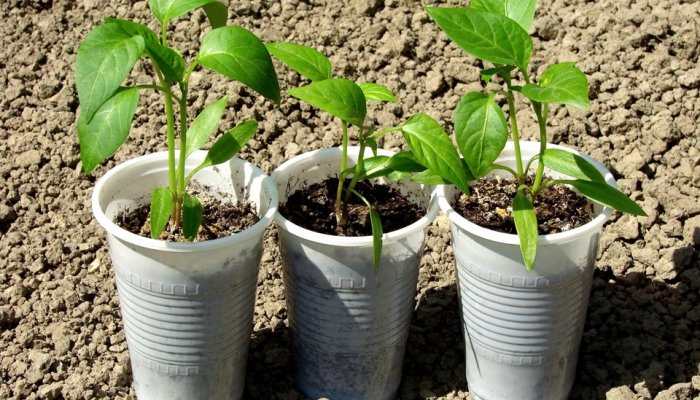 It is difficult to grow bell pepper, as he loves warmth, quality care and the implementation of all agricultural practices. Nevertheless, culture is so popular among Russian summer residents. After collecting a good harvest, you can provide yourself with useful substances for a long time. In 50 g of fruits, the daily norm of vitamin C is contained.
It is difficult to grow bell pepper, as he loves warmth, quality care and the implementation of all agricultural practices. Nevertheless, culture is so popular among Russian summer residents. After collecting a good harvest, you can provide yourself with useful substances for a long time. In 50 g of fruits, the daily norm of vitamin C is contained.
How does pepper cultivation begin in almost all regions? Of course, from seedlings. It is at this stage in the development of culture that it is most at risk. Fresh young shoots are very attractive to harmful insects. They can be destroyed, but it’s more difficult to cope with diseases. So it is better to try to avoid them by conducting prophylaxis and following agrotechnical recommendations. And the ailment that has already appeared needs to be noticed in a timely manner and proceed to treatment, destroying the affected plants.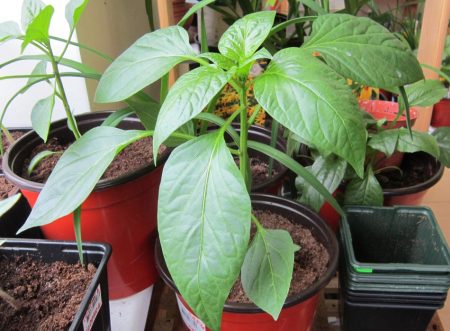
There are several groups of diseases of pepper seedlings. Let us dwell on each.
Content
Fungal diseases of pepper seedlings
The most common diseases make up 80%. Spores get to seedlings with the help of wind, rain, insects. They are stored for a long time in the ground and plant debris.
Blackleg
It attacks seedlings in the period from the formation of sprouts to the appearance of 2-3 real leaves. The main symptom is a darkening of the root neck of the shoot and a black constriction in the lower part of the stem. If the peppers grow in a humid environment, the plant tissue will soften, the stem will break, and the shoot will die.
Black-footed fungi live on top of the ground. In contact with the roots of pepper sprouts at high humidity, pathogens spread to the culture.
The black leg appears due to disturbed growing conditions, which include:
You need to prevent infection with the black leg before sowing seeds as follows:
- acquire quality disease-resistant seeds;
- heat the soil mixture in the oven, steam and cool at the beginning of frost;
- pour the material ready for planting with a solution of potassium permanganate or means: Renaissance, Radiance, Baikal;
- hold the seeds in potassium permanganate, and then wash and plant;
- to process planting material with immunomodulators, for example, Epin-Extra, Immunoficiency, Agat-25 K;
- use fungicides - Maxim, Fitosporin-M, Fitoros, placing seeds in a tissue bag and processing, according to the annotation;
- add Trichodermin biological agent to the soil, suppressing not only the black leg, but also 60 other pathogens of root rot;
- dive seedlings and not thicken plants;
- ventilate the room where pepper seedlings are located, but not immediately after watering;
- to supply plants with water often, but in small portions, and not vice versa;
- sprinkle the soil with seeds or pickled seedlings with pre-calcined river sand, crushed coal or ash;
- at the beginning of the disease, remove defective shoots, and healthy ones should be planted and sprayed with Bordeaux liquid or potassium permanganate, and then watered with fungicides
According to experts, peat tablets disinfected and treated with a fungicide are suitable for growing pepper seedlings.
Gray rot
If on the lower part of the stem, which touches the ground, wet white spots have formed that become covered with plaque, then the plant is infected with gray rot.
Spores are stored in plant debris for a long time, they are carried by insects, wind and water. In high humidity, warm spores can germinate and infect crops.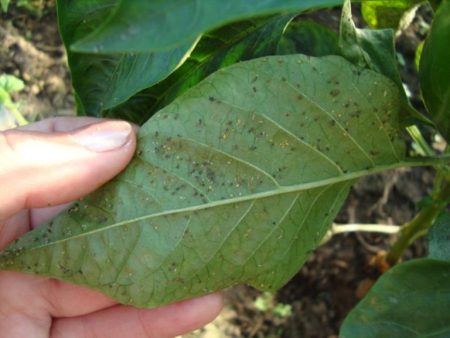
To get rid of gray rot, you need:
- for prevention in time to air the seedlings;
- destroy diseased plants, and healthy ones should be placed in another container;
- at the beginning of the development of the disease, treat the sprouts with crushed tablets of activated carbon or chalk;
- spray the shoots with garlic tincture: dissolve 30 g of grated garlic in about 5 liters. water and insist 2 days;
- treat pepper seedlings with copper sulfate or Bordeaux liquid, potassium permanganate, Kuproksat;
- use products that not only protect, but also treat plants, and also prevent the formation of spores - Previkur, Ordan, Fundazol, Skor, Acrobat
Late blight
The first signs resemble a black leg. A constriction forms near the root, and a silky white coating forms on the infected tissue, which indicates the maturation of spores.
Measures for the prevention and control of the disease are as follows:
- selection of varieties not sensitive to late blight;
- soaking seeds in a solution of potassium permanganate before sowing;
- compliance with all agricultural techniques during cultivation, including a decrease in humidity;
- spraying freshly infected shoots with iodine solution (5 ml per 1 liter of water);
- alternate use of Barrier and Barrier funds;
- fertilizing the soil with potassium-phosphorus mixtures to quickly increase their stability;
- treatment of shoots with whey or garlic: 50 g dissolve in 10 liters. water and leave for a day, which will give an excellent result in 10 days;
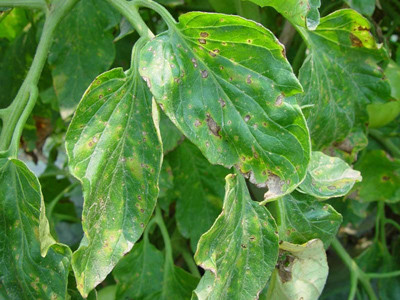
- with the ineffectiveness of other methods, the use of such compositions as Tattu, Quadrice, Champion, Ridomil Gold, with a clear implementation of the recommendations
Fusarium and sclerocinia
In another way, both of these diseases are called wilting. They appear as follows: first the leaves fall off the plant, and then it dries. If you cut across the basal neck of pepper, you can see infected brown clogged vessels.
The disease begins with rotting of the root system. Active spores penetrate first into small roots, and then, with the growth of mycelium, into large ones. The plant dies due to the fact that vital processes are inhibited. This is due to clogging of the vessels with fungal mycelium and poisoning by harmful compounds.
The disease is actively spreading with high humidity, temperature fluctuations, malnutrition, weak plant immunity, and pest damage. The first time it is difficult to detect the disease. Destroyed shoots cannot be cured. Gardeners should think about saving healthy peppers. To do this, you must:
- remove affected bushes;
- treat the soil with potassium permanganate or Planzir;
- use the same preventive measures as with late blight;
- select varieties of pepper that are not susceptible to the disease;
- preplant seed treatment with Fundazol
Important: Fusarium spores are stored in the soil for up to 10 years.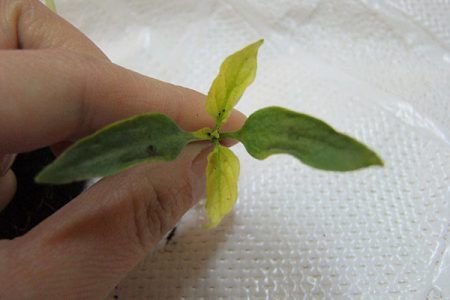
As a rule, spores live in rotting plant debris. Therefore, the garden must be kept clean.
Bacterial diseases
The causative agents of these ailments are bacteria. They have no obvious signs, they can be combined with other diseases, so it is very difficult to make a correct diagnosis.
Garden crops suffer greatly from bacteria, which, damaging plants partially or completely, causing their death. For example, vascular lesions, root rot, tumors and necrosis look like burns or spotting.
Peppers are infected by bacteria through small holes that appear naturally or after mechanical deformation. Pathogens are transmitted by bacteria and animals.
A favorable environment and nutritious plant debris help bacteria stay in the ground for a long time.
Black spotting
It can appear on the plant immediately after the formation of sprouts.The stems and foliage are covered with dark, growing spots, bordered with yellow, as a result of which the shoots dry out.
We list the main preventive and treatment measures:
- acquire basic and hybrid cultivars that are not sensitive to bacteria;
- disinfect the seeds before planting, lowering them into a solution of potassium permanganate for 10 minutes, and rinse; you can use the tool Fitolavin-300;
- destroy infected pepper seedlings;
- disinfect the soil before planting: steam, freeze, calcine;
- spray seedlings with Bordeaux fluid
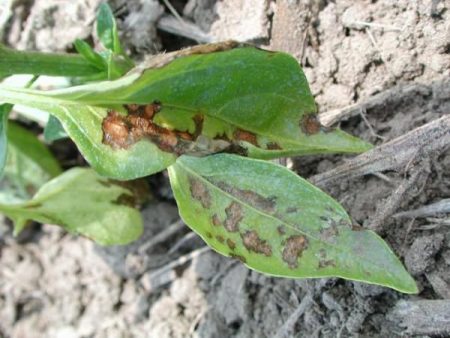
Lightning wilting
Pathogens are inside the plant and affect its vascular system. As a result, nutrients do not reach the desired sites. In addition, harmful products of pests are released. When an incision is made in the stem, a white liquid appears.
How to deal with the problem:
- remove all diseased instances;
- dress the seeds before planting with a folk remedy (chop 2 cloves of garlic and add water, dip the seeds there for half an hour), rinse and dry them, and only then sow;
- do not plant seedlings after nightshade (crop rotation rule);
- if the previous paragraph is not possible to observe, change and disinfect the soil every year;
- control temperature and humidity;
- follow the recommended scheme for planting seedlings;
- for prevention, treat the culture with copper-containing agents;
- constantly feed the plants so that they have enough strength to resist disease
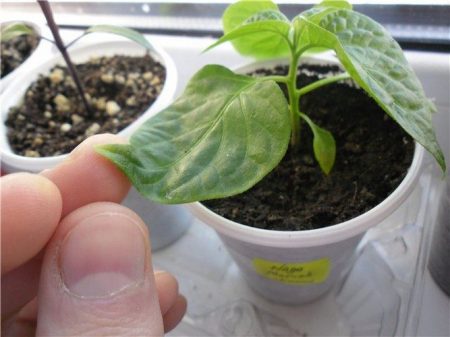
Soft rot
It affects all parts of the plant. Bacteria penetrate the vessels and prevent them from functioning properly. As a result, the bushes die off and may die. The disease is active in humid, warm weather.
To avoid infection, you need to:
- etch planting material;
- disinfect the soil;
- ventilate greenhouses, water the seedlings in the right amount, prevent moisture stagnation in pallets;
- remove all plant debris, because it is there that pathogens breed
Pepper cancer
It develops in a humid climate with a temperature of 25-30 degrees, if the bushes grow close to each other. Bacteria carriers - insects and people using garden tools.
A disease can affect every part of the plant. Symptoms of cancer are dark brown spots, bright in the center. Over time, they combine, and a crust forms on them.
Recommendations for treatment and prevention:
- First, treat all affected shoots with copper-containing compounds (copper sulfate or copper oxide);
- get rid of all infected instances;
- in greenhouses and greenhouses, where cultures with bacterial cancer grew, thoroughly treat with methyl bromide and replace the soil
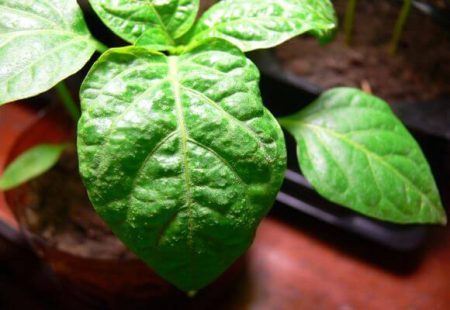
Viruses
Carriers: thrips, aphids and nematodes. Viruses are very small, so you can only see them through a microscope. Plants are not affected as often as bacteria, but they do more harm.
The virus cannot live without the cells of the body in which it parasitizes. It acts only when it is in it, which explains plant defects. Shoots no longer grow, their stems and leaves are bent.
For wintering, viruses remain in the dried parts of plants, in the body of insects and seeds. They are very partial to the shoots of pepper.
Tobacco mosaic
The virus enters the cells, destroying chlorophyll. The leaves become marbled in white or emerald speck. Due to this pattern, the disease acquired its name. As a result, the cells die.
A virus will not kill a plant if:
- do preplant seed treatment;
- carefully pinch seedlings, given that viruses make their way into damaged cells;
- fight harmful insects that carry pathogens;
- monitor the condition of the greenhouse and change the soil if necessary;
- one week before planting, spray seedlings with boric acid and repeat 7 days after moving to open ground to increase pepper immunity;
- do not leave parts of plants in greenhouses
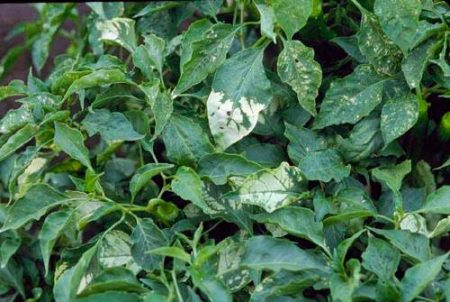
The tobacco mosaic virus lives in soil and grass residues up to 5 years.
Stolbur
First affects the upper sections of seedlings. Culture stops growing and becomes dwarf. Leaves curl, their edges turn yellow. The disease is carried by thrips, spider mites and aphids. Varieties and hybrids of pepper are unstable to this scourge.
Precautionary measures:
- the destruction of diseased shoots;
- disinfection of soil and seeds;
- implementation of crop rotation rules when growing peppers;
- greenhouse soil change
There are currently no anti-pillar drugs available.
Reviews
The topic of diseases of seedlings of garden crops is very much discussed on the forums. Here are some examples:
“Recently I read how to sanitize purchased soil. To do this, you can use "Baikal" and other EM drugs. 14 days before the Baikal procedure, you need to fill in a ratio of ½ cup per 10 liters. Soil, roll the free circle of the package into a tube to squeeze out the air and put in a warm, unlit place. Then beneficial microorganisms will multiply and suppress pathogens. I'll try next year. Now they began to sell disgusting land! ”(Elena, Kostroma);
“My seedlings are not growing, but I know a situation when a friend added peat to the ground. Someone told her that its black color is a sign of usefulness and needs to be added more. As a result, some stems and stepsons stopped developing. There was a suspicion of viruses or fungus. Peat was acidic, which led to spoilage of seedlings. In this case, ash will help: it is necessary to water the plants or add it in a dry form. It’s too late to change the soil ”(Victor, Novosibirsk)
“I use only the proven Bordeaux fluid, which has been in demand for 100 years. In addition, it does not cost as much as all these HOMs. She needs to process the inside of the leaves and around the bush. I add another complex of trace elements. Also, so that there are no diseases, you need to feed the peppers well, but do not go too far ”(Lyudmila, Nizhny Novgorod)
Sweet pepper seedlings can suffer from various ailments. But there are no hopeless situations. After all, as a rule, all diagnoses of plants are the result of non-compliance with the rules of agricultural technology. You need to be more attentive to garden crops, and then they will give a rich harvest.

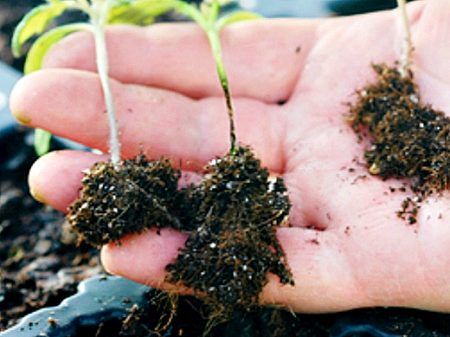



 Calorie pepper stuffed with meat and rice - BZHU per 100 grams
Calorie pepper stuffed with meat and rice - BZHU per 100 grams Gorky pepper - the best varieties for open ground
Gorky pepper - the best varieties for open ground Hot pepper seeds - the best varieties for open ground and reviews
Hot pepper seeds - the best varieties for open ground and reviews Capsicum tincture for hair - how to use and reviews
Capsicum tincture for hair - how to use and reviews